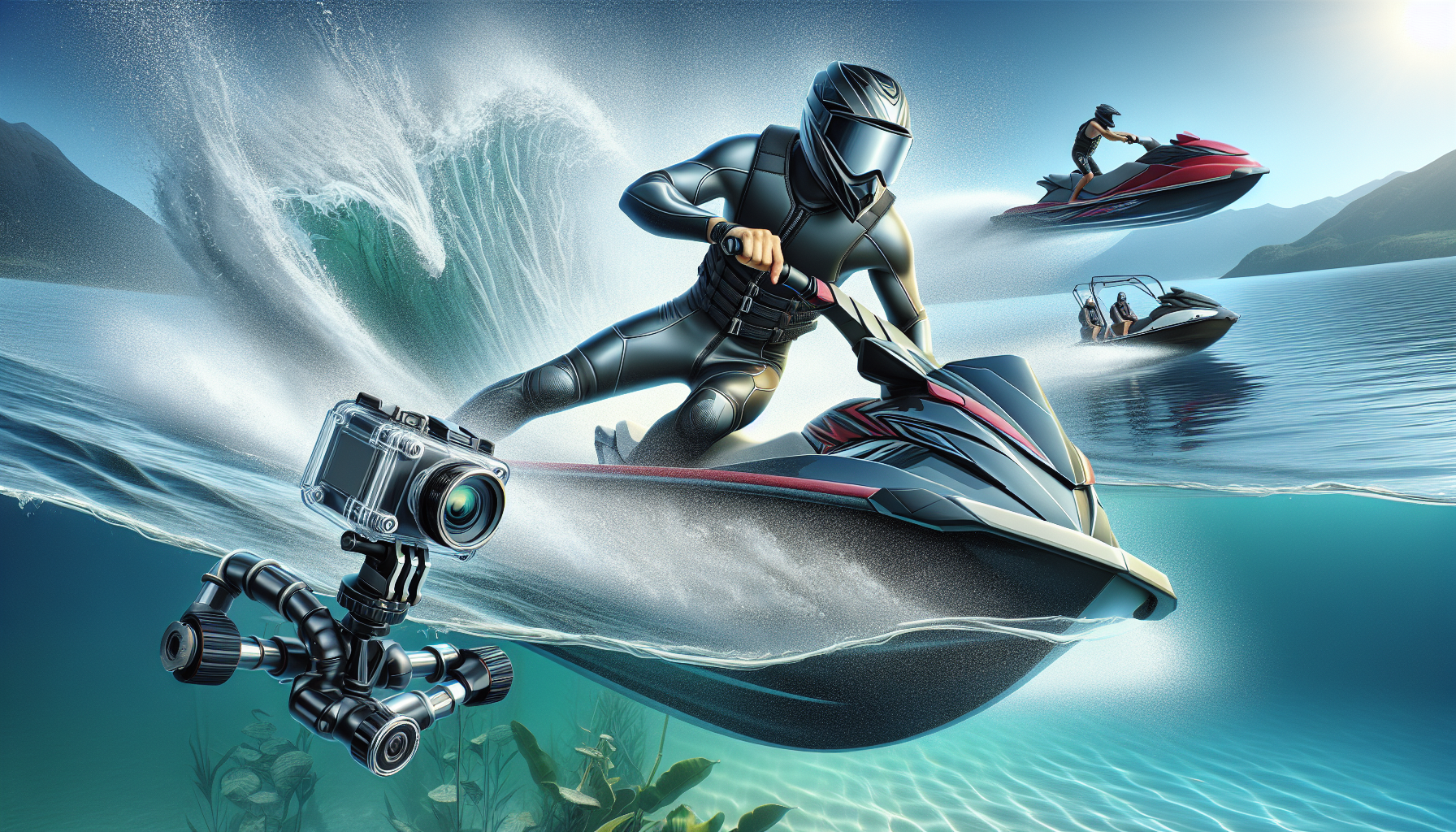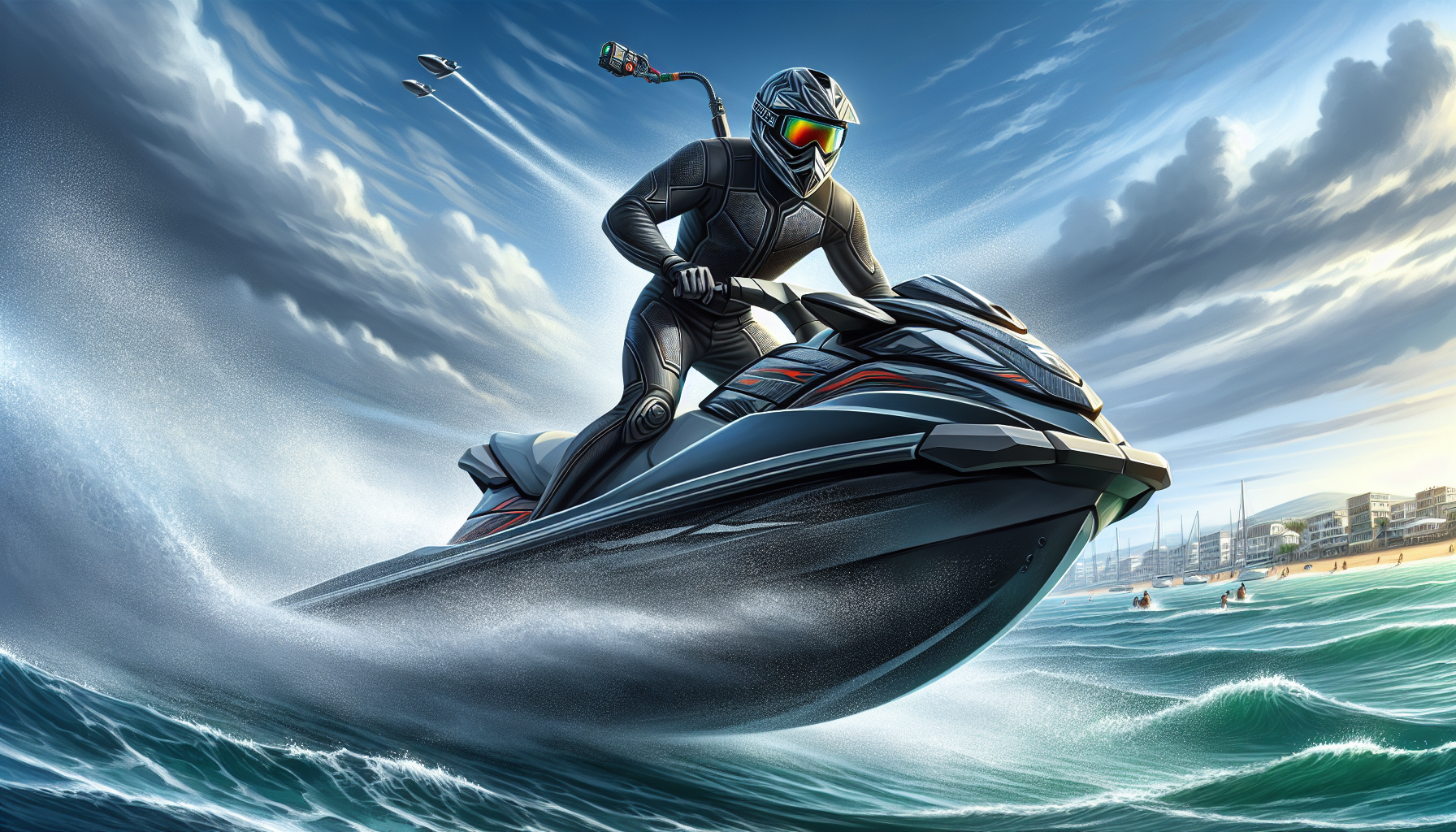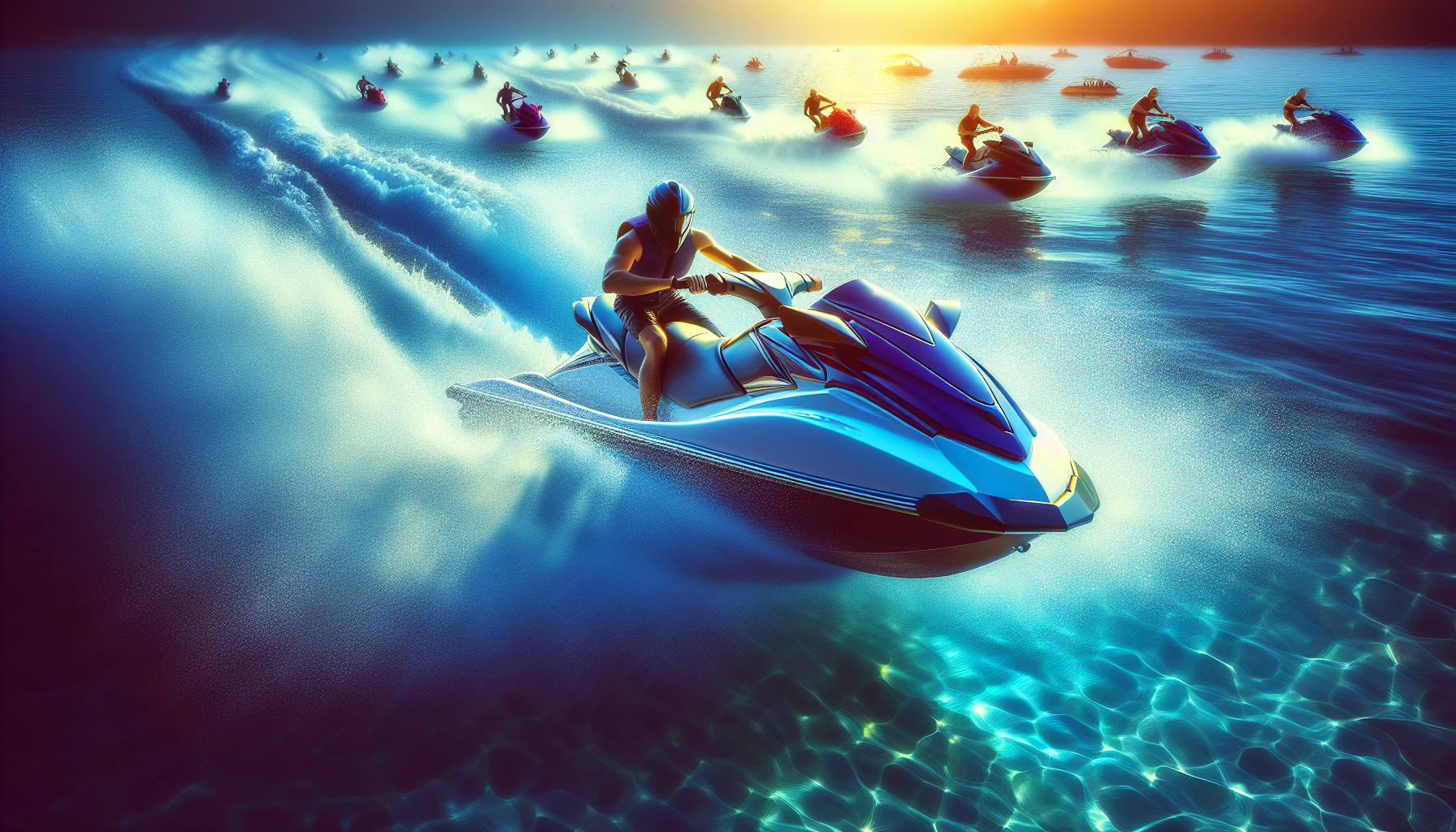Top Equipment and Accessories for Jet Skiers

Are you an avid jet skier looking for the top equipment and accessories to enhance your experience on the water? Look no further! In this article, we will explore the must-have gear for jet skiers that will take your riding to the next level. From safety essentials such as life jackets and helmets to performance-enhancing gadgets like GPS navigation systems and waterproof cameras, we’ve got you covered. Whether you’re a seasoned rider or just starting out, equipping yourself with the right tools is crucial for a safe and enjoyable jet skiing adventure. So, read on to discover the best equipment and accessories in the industry, and don’t forget to contact the watersport experts at A2Z Powersport in Orange Beach, Alabama for all your jet ski rental needs. Trust their expertise and passion for watersports to provide you with an unforgettable experience on the waves.
Jet Skis
If you’re an adventure enthusiast who loves the water, then jet skiing is the perfect activity for you. Jet skis offer an exhilarating experience as you glide across the water at high speeds. But before you hit the waves, it’s important to ensure that you have the right equipment and accessories to not only enhance your experience but also keep you safe on the water. In this article, we will explore the essential equipment and accessories for jet skiers, including jet skis themselves, life jackets, wetsuits, helmets, goggles, gloves, footwear, dry bags, GPS/navigation systems, and jet ski anchors. So let’s dive in and discover everything you need to know!
Types of Jet Skis
When it comes to jet skis, there are various types available to suit different preferences and skill levels. Here are some of the most common types:
-
Stand-Up Jet Skis: These jet skis are designed to be ridden in a standing position and offer a more thrilling and challenging experience. They require greater skill and balance to maneuver but are favored by adrenaline junkies.
-
Sit-Down Jet Skis: As the name suggests, sit-down jet skis allow you to sit comfortably while riding. They offer a more relaxed and stable ride, making them suitable for beginners and those looking for a more leisurely experience.
-
Recreational Jet Skis: These jet skis are designed for general recreational use and are versatile enough to handle various water conditions. They often come with extra storage compartments and additional features to enhance your comfort and convenience.
-
Performance Jet Skis: If you’re a thrill-seeker and want a jet ski that can reach incredible speeds, then performance jet skis are for you. These machines are built for speed, agility, and maneuverability, allowing you to push the limits and experience the ultimate adrenaline rush.
-
Touring Jet Skis: If you love going on long rides or exploring different waterways, then touring jet skis are the ideal choice. They offer a comfortable ride with features like larger fuel tanks, more storage space, and enhanced stability for extended journeys.
Before purchasing or renting a jet ski, it’s essential to consider your skill level, intended use, and personal preferences to ensure that you choose the right type of jet ski that suits you best.
Features to Consider when Choosing a Jet Ski
While selecting a jet ski, it’s crucial to consider various features that can greatly impact your riding experience. Here are some important factors to keep in mind:
-
Engine Power: The engine power of a jet ski determines its speed and acceleration capabilities. Higher engine power provides a more thrilling and faster ride, but it also requires greater skill to handle. Consider your skill level and riding preferences when choosing the appropriate engine power.
-
Stability: Stability is a crucial factor, especially for beginners or those who prefer a more relaxed ride. Look for jet skis with wider hulls or additional stability features like hull designs and stabilizers to ensure a stable and balanced experience.
-
Storage Capacity: If you plan on carrying extra gear or going on longer rides, pay attention to the storage capacity of the jet ski. Look for compartments or storage areas that can accommodate your belongings and keep them secure while you ride.
-
Maneuverability: The maneuverability of a jet ski determines how easily you can handle and control the machine. Consider factors such as turning radius, responsiveness, and agility to ensure that the jet ski offers the level of maneuverability you desire.
-
Comfort: Comfort is an essential aspect, especially during longer rides. Look for features like adjustable seats, ergonomic handlebars, and shock-absorbing systems to ensure a comfortable and enjoyable experience.
By considering these features and choosing a jet ski that aligns with your preferences and requirements, you can enhance your jet skiing experience and make the most out of your time on the water.
Life Jackets
When participating in any water-based activity, safety should be your top priority. This is where life jackets come in. A life jacket, also known as a personal flotation device (PFD), is an essential piece of equipment that can save your life in case of an emergency. Whether you’re a beginner or an expert jet skier, wearing a life jacket is non-negotiable. Let’s explore the importance of wearing a life jacket and the different types available.
Importance of Wearing a Life Jacket
Wearing a life jacket while jet skiing is crucial for several reasons:
-
Personal Safety: A life jacket ensures that you stay afloat in the water, even if you’re injured or unconscious. It provides buoyancy and keeps your head above the water, allowing you to breathe and minimizing the risk of drowning.
-
Emergency Situations: Accidents can happen unexpectedly, even to the most experienced jet skiers. A life jacket gives you peace of mind knowing that you’re prepared for any emergency, such as engine failure, collision, or rough water conditions.
-
Legal Requirements: In many jurisdictions, wearing a life jacket while operating a jet ski is not only common sense but also a legal requirement. Failing to wear a life jacket can result in fines or other legal consequences, so it’s important to comply with local regulations.
-
Setting an Example: If you’re jet skiing with friends or family, wearing a life jacket sets a positive example for others. By demonstrating responsible behavior, you encourage those around you to prioritize their safety as well.
Types of Life Jackets
When choosing a life jacket for jet skiing, it’s essential to select one specifically designed for water sports. Here are some common types of life jackets suitable for jet skiers:
-
Type I: Also known as offshore life jackets, Type I jackets offer the highest level of buoyancy and are suitable for use in rough or remote water conditions. They provide excellent flotation and can turn an unconscious person face-up in the water.
-
Type II: Type II life jackets, often referred to as near-shore buoyant vests, are designed for use in calmer waters where rescue is expected to be quick. They offer good buoyancy and are comfortable to wear for extended periods.
-
Type III: Type III life jackets, also known as flotation aids, are commonly used for water sports. They provide good buoyancy while allowing freedom of movement. These life jackets are suitable for jet skiing, as they offer a balance between comfort and safety.
-
Type V: Type V life jackets are specialized models designed for specific activities. They include inflatable life jackets, hybrid inflatables, and deck suits. These jackets are compact, lightweight, and offer excellent mobility. However, they require activation and proper usage to provide buoyancy.
When selecting a life jacket, ensure that it fits you properly and is Coast Guard-approved. It’s important to choose a life jacket that suits your weight, size, and intended use to ensure maximum safety and comfort on the water.
Wetsuits
If you’re planning to jet ski in cooler water temperatures, a wetsuit is an essential piece of gear to consider. Wetsuits are designed to provide insulation and protection against the cold water, while also offering additional benefits for jet skiers. Let’s explore the benefits of wearing a wetsuit and the different types available.
Benefits of Wearing a Wetsuit
Wearing a wetsuit while jet skiing offers several advantages:
-
Thermal Protection: The primary purpose of a wetsuit is to provide thermal insulation in cold water. The neoprene material traps a thin layer of water between your skin and the suit, which is then warmed by your body heat, creating a protective barrier against the cold.
-
Buoyancy: Wetsuits provide additional buoyancy, making it easier to stay afloat and reducing fatigue while swimming or waiting for assistance in case of an emergency. This is especially useful if you find yourself in rough water conditions.
-
Protection from Sun and Elements: In addition to insulation, wetsuits also provide protection against the sun’s harmful UV rays, wind, and other elements. This is particularly important if you’re spending long hours on the water, as prolonged exposure to the sun can result in sunburn and dehydration.
-
Abrasion Resistance: Wetsuits offer a certain degree of protection against cuts, scrapes, and abrasions that may occur while jet skiing. The neoprene material acts as a barrier, reducing the risk of injuries if you accidentally fall off the jet ski or come into contact with objects in the water.
Types of Wetsuits
There are different types of wetsuits available, each suited for specific water temperatures and personal preferences. Here are the most common types:
-
Full Wetsuits: Also known as steamer wetsuits, full wetsuits cover your entire body from the neck down and are suitable for colder water temperatures. They provide maximum coverage and insulation, keeping you warm even in chilly conditions.
-
Springsuits: Springsuits, also called shorties, are wetsuits with short legs and short or no sleeves. They are ideal for milder water temperatures and offer increased flexibility and freedom of movement.
-
Long John Wetsuits: Long John wetsuits have full-length legs, similar to a full wetsuit, but no sleeves. They provide good insulation for the lower body while allowing more freedom for the arms.
-
Tops and Bottoms: For ultimate customization, you can opt for separates that include wetsuit tops and bottoms. This allows you to choose different thicknesses and coverage levels based on your needs and preferences.
When selecting a wetsuit, consider the water temperature, the duration of your ride, and your personal comfort preferences. A properly fitting wetsuit should be snug but not restrictive, allowing for ease of movement while providing optimal thermal protection.
Helmets
When engaging in any high-speed water sport like jet skiing, protecting your head should be a top priority. Wearing a helmet is crucial for your safety, as it can minimize the risk of head injuries in case of a collision or fall. Let’s explore the importance of wearing a helmet while jet skiing and the different types available.
Importance of Wearing a Helmet
Wearing a helmet while jet skiing offers several important benefits:
-
Head Protection: A helmet provides a layer of protection for your head, reducing the impact of potential collisions or falls. It can mitigate the risk of head injuries, concussions, and skull fractures, which can have long-lasting and detrimental effects.
-
Impact Absorption: Helmets are designed to absorb and distribute the force of impact. The outer shell and padding help cushion the blow, minimizing the risk of traumatic brain injuries.
-
Protection from Debris: While jet skiing, you may encounter waves, water splashes, or other debris that could potentially hit your head. A helmet acts as a shield, providing protection against flying objects and water-related injuries.
-
Increased Visibility: Some helmets are equipped with built-in visors that shield your eyes from the sun’s glare and spray, allowing for better visibility and reducing the risk of accidents caused by impaired vision.
Types of Jet Ski Helmets
When it comes to jet ski helmets, there is a range of options available. Here are some common types:
-
Full-Face Helmets: Full-face helmets provide the highest level of protection as they cover your entire face, including your chin and jaw. They offer impact resistance and protect your face from water, wind, and debris. Full-face helmets are recommended for those seeking maximum protection, especially for high-speed jet skiing.
-
Half Helmets: Half helmets, also known as open-face helmets, cover the top and sides of your head but leave your face exposed. They offer a compromise between protection and visibility, providing ample head coverage while allowing more freedom and ventilation.
-
Multi-Sport Helmets: Multi-sport helmets are versatile options that can be used for various water and land-based activities. They often feature removable or interchangeable parts, such as visors or ear protection, allowing you to customize the helmet based on your specific needs.
-
Dual-Density Foam Helmets: Dual-density foam helmets provide enhanced impact protection by incorporating different foam densities. They are designed to absorb and disperse impact forces more effectively, offering superior safety in case of a collision.
When selecting a helmet, ensure it is specifically designed and approved for water sports use. Look for features like adjustable straps, ventilation systems, and a comfortable fit to ensure that you can ride safely and comfortably.
Goggles
Protecting your eyes while jet skiing is essential, as they are vulnerable to various hazards such as sun glare, water spray, wind, and debris. Wearing goggles can keep your eyes shielded and ensure a clear and safe riding experience. Let’s explore the importance of wearing goggles while jet skiing and the different types available.
Importance of Wearing Goggles
Wearing goggles offers several benefits for jet skiers:
-
Eye Protection: Goggles provide a barrier against water splashes, wind, and debris, preventing them from directly contacting your eyes. They protect your eyes from irritation, discomfort, and potential injuries, ensuring a safe and enjoyable ride.
-
UV Protection: Goggles with UV protection lenses shield your eyes from the sun’s harmful ultraviolet (UV) rays. Prolonged exposure to UV rays can lead to eye damage, including cataracts and macular degeneration. Goggles with proper UV protection can significantly reduce the risk of these conditions.
-
Enhanced Vision: Goggles designed for water sports often have tinted lenses or anti-glare coatings to improve visibility under bright conditions. They reduce sun glare off the water, allowing you to see more clearly and enhancing your overall riding experience.
-
Comfort and Convenience: Goggles with a snug and comfortable fit prevent water from entering your eyes, eliminating the need for constant blinking or wiping. This ensures that you can focus on riding without any distractions.
Types of Goggles
There is a wide range of goggles available, each offering unique features to cater to different preferences and riding conditions. Here are some common types of goggles for jet skiing:
-
Ski Goggles: Ski goggles are versatile options suitable for various water sports, including jet skiing. They often feature a wide field of vision, adjustable straps, and vented frames to minimize fogging. Ski goggles with polarized lenses are particularly effective in reducing glare and enhancing visibility.
-
Kite Surfing Goggles: Kite surfing goggles are specifically designed for high-speed water sports and offer excellent impact resistance. They have a secure fit and a watertight seal to prevent water from seeping into your eyes, even in turbulent conditions.
-
Swim Goggles: Swim goggles designed for competitive swimming can also be used for jet skiing. They offer a streamlined design, minimal drag, and a comfortable fit. However, swim goggles may not provide the same level of impact resistance as goggles specifically designed for water sports.
-
Prescription Goggles: If you require vision correction, prescription goggles can be a great option. These goggles allow you to see clearly while enjoying the benefits of eye protection. They can be customized to match your precise prescription, ensuring optimal vision and safety.
When choosing goggles, consider factors such as lens tint, fog resistance, lens coatings, and fit. Look for goggles that provide a secure and comfortable fit around your eyes to ensure they stay in place during your jet skiing adventures.
Gloves
While gloves may not be the first item that comes to mind when thinking about jet skiing, they can greatly enhance your riding experience and provide essential protection for your hands. Let’s explore the importance of wearing gloves while jet skiing and the different types available.
Importance of Wearing Gloves
Wearing gloves offers several advantages for jet skiers:
-
Hand Protection: Jet skiing can expose your hands to various hazards such as sunburn, windburn, blisters, and potential impacts. Gloves provide a protective layer between your hands and the elements, reducing the risk of injuries and discomfort.
-
Improved Grip: Maintaining a firm grip on the handlebars is crucial for control and maneuverability while jet skiing. Gloves with textured or grippy palm surfaces enhance your grip on the handlebars, even in wet or slippery conditions.
-
Reduced Fatigue: Prolonged exposure to water, wind, and vibrations from the jet ski can lead to hand fatigue. Gloves with padded or cushioned palms help absorb vibrations, reducing hand fatigue and allowing you to ride for longer periods with greater comfort.
-
Sun Protection: Gloves with UV protection can shield your hands from harmful UV rays, preventing sunburn and long-term skin damage. This is particularly important if you’re jet skiing in sunny or tropical locations.
Types of Jet Ski Gloves
There are various types of gloves designed specifically for water sports, each offering unique features to suit different needs and preferences. Here are some common types of jet ski gloves:
-
Fingerless Gloves: Fingerless gloves provide coverage for your palms and the backs of your hands while leaving your fingers exposed. They offer a balance between protection and dexterity, allowing you to maintain finger mobility for tasks like operating the controls, using your phone, or adjusting equipment.
-
Full-Finger Gloves: Full-finger gloves provide complete coverage for your hands, including your fingers. They offer enhanced protection against sunburn, windburn, and potential impacts. Full-finger gloves are recommended if you’re seeking maximum hand protection and warmth, especially in colder water conditions.
-
Neoprene Gloves: Neoprene gloves are ideal for colder water temperatures as they provide insulation and keep your hands warm. The neoprene material also offers excellent dexterity, allowing you to maintain finger mobility while protecting against the cold.
-
Thermal Gloves: Thermal gloves are designed for extreme cold water conditions. They are often made from materials like neoprene with additional insulation layers to provide maximum warmth and protection. These gloves are suitable for colder climates or winter jet skiing.
When choosing gloves, consider factors such as fit, grip, durability, and the level of protection required. Opt for gloves that are comfortable, waterproof, and offer the features you need for a safe and enjoyable jet skiing experience.
Footwear
When it comes to jet skiing, the right footwear is crucial for both safety and comfort. The right pair of shoes can provide excellent traction, protect your feet from potential injuries, and enhance your overall riding experience. Let’s explore the different types of jet ski footwear and the important features to consider.
Types of Jet Ski Footwear
There are various types of shoes designed specifically for water sports, each offering unique features to suit different needs and preferences. Here are some common types of jet ski footwear:
-
Water Shoes: Water shoes are versatile and suitable for various water activities, including jet skiing. They are lightweight, flexible, and designed to provide excellent traction on slippery surfaces. Water shoes often have a durable sole with drainage holes to prevent water from pooling inside the shoe.
-
Aquatic Sneakers: Aquatic sneakers offer more coverage and protection compared to water shoes. They are similar to regular sneakers but are made from quick-drying materials and have soles with excellent grip. Aquatic sneakers provide extra comfort and support for your feet during prolonged jet skiing sessions.
-
Neoprene Booties: Neoprene booties are ideal for colder water temperatures as they provide insulation and protection against the cold. These booties are designed to fit snugly around your feet, minimizing water entry and keeping your feet warm. Neoprene booties often have a sturdy sole for stability and traction.
-
Deck Shoes: Deck shoes, also known as boat shoes, are designed for use on boats and other watercraft. They offer excellent traction on wet surfaces and provide protection against slips and falls. Deck shoes often feature non-marking rubber soles and quick-drying materials for your comfort and safety.
Features to Consider when Choosing Jet Ski Footwear
When selecting footwear for jet skiing, it’s important to consider several features that can greatly impact your performance and safety. Here are some important factors to keep in mind:
-
Traction: The footwear should have a reliable sole with specialized grip patterns or textures to provide excellent traction on wet surfaces. This ensures that you maintain a secure footing while boarding the jet ski or moving around on slippery surfaces.
-
Drainage: Look for footwear with drainage systems to allow water to escape from the shoe, preventing it from becoming weighed down or causing discomfort. Drainage holes or channels in the sole help to keep your feet dry and ensure a comfortable ride.
-
Comfort and Fit: The footwear should provide a snug and comfortable fit to prevent foot movement inside the shoe. It should also have sufficient padding or cushioning to absorb shocks and vibrations, reducing foot fatigue during longer rides.
-
Protection: Your footwear should protect your feet from potential injuries and hazards, such as sharp objects in the water or accidental impacts. Look for shoes with reinforced toe caps, durable materials, and adequate coverage for maximum foot protection.
-
Quick-Drying Materials: Choosing footwear made from quick-drying materials like neoprene or mesh allows water to evaporate quickly, preventing your feet from staying wet for long periods. This helps maintain comfort and reduces the risk of water-related skin issues.
By considering these features and choosing footwear that provides the right combination of traction, comfort, protection, and quick-drying properties, you can ensure a safe and enjoyable jet skiing experience.
Dry Bags
When jet skiing, it’s important to keep your personal belongings safe and dry. This is where dry bags come in handy. Dry bags are specially designed bags that keep your items protected from water, ensuring that they stay dry even in wet conditions. Let’s explore the importance and benefits of using dry bags while jet skiing and the different types available.
Importance and Benefits of Using Dry Bags
Using dry bags while jet skiing offers several advantages:
-
Waterproof Protection: Dry bags are completely waterproof and keep your valuables, such as your phone, wallet, keys, and extra clothing, free from water damage. They provide an airtight seal that prevents water from seeping inside, even when exposed to splashes or submersion.
-
Floatation: Dry bags often have added buoyancy, allowing them to float on the water if accidentally dropped overboard. This makes retrieving your belongings much easier and minimizes the risk of losing them in deep water.
-
Organization and Convenience: Dry bags come in various sizes, allowing you to organize your items based on their size and importance. They often have adjustable straps or handles for easy carrying, and some even come with additional compartments or pockets for better organization.
-
Versatility: Dry bags can be used for more than just jet skiing. They are perfect for a wide range of water activities, including kayaking, paddleboarding, and boating. They also serve as excellent travel companions for beach trips, camping, or any other outdoor adventures where protection from water is necessary.
Types of Dry Bags
Dry bags come in different sizes, shapes, and materials to accommodate your specific needs. Here are some common types of dry bags:
-
Roll-Top Dry Bags: Roll-top dry bags are the most common type and feature a closure system where the top is folded over multiple times and secured with clips or buckles. This creates a watertight seal, ensuring that your items remain dry.
-
Zipper Seal Dry Bags: Zipper seal dry bags use a waterproof zipper closure instead of rolling the top. They provide quick and easy access to your belongings and offer an additional layer of protection against water.
-
Backpack Dry Bags: Backpack dry bags combine the features of a dry bag and a backpack, allowing you to carry your belongings comfortably on your back. They have padded shoulder straps, multiple compartments, and often include additional features like external pockets or attachment points.
-
Duffel Dry Bags: Duffel dry bags have a cylindrical shape with a wide opening for easy packing and access to your items. They usually have a removable shoulder strap and are great for carrying larger or bulkier items.
When choosing a dry bag, consider the size and capacity you require, the closure system, the material’s durability, and any additional features that may be useful for your specific needs. Ensure that the dry bag is sealed properly before each use to maintain its waterproof functionality.
GPS/Navigation Systems
While jet skiing, navigating through vast waterways can be challenging, especially if you’re in unfamiliar territory. GPS/navigation systems can greatly enhance your jet skiing adventures by providing you with accurate navigation, safety features, and peace of mind. Let’s explore the importance of GPS/navigation systems for jet skiers and some popular options available.
Importance of GPS/Navigation Systems for Jet Skiers
GPS/navigation systems offer several important benefits for jet skiers:
-
Accurate Navigation: GPS systems provide real-time positioning and accurate tracking of your location. They allow you to set waypoints, mark areas of interest, and plan routes, ensuring that you stay on course and reach your destination safely.
-
Safety Features: Many GPS/navigation systems for water sports include safety features such as man overboard alerts, emergency call functions, and tracking capabilities. These features allow you to quickly and effectively respond to emergencies or inform others of your location if assistance is needed.
-
Hazards and Points of Interest: GPS systems often come preloaded with maps that indicate hazards like shallow areas or submerged objects. They also provide information on marinas, fuel stops, restaurants, and other points of interest, making it easier to plan your stops or find nearby facilities.
-
Weather and Tides: Some GPS/navigation systems have built-in weather and tide information, allowing you to monitor changing conditions and plan your rides accordingly. This helps you avoid rough seas, storms, or unfavorable conditions that could compromise your safety.
Popular GPS/Navigation Systems for Jet Skis
When it comes to GPS/navigation systems for jet skis, there are numerous options available. Here are some popular systems to consider:
-
Garmin GPSMAP Series: The Garmin GPSMAP series offers a range of handheld GPS devices specifically designed for boating and water sports. They feature comprehensive mapping options, marine and road navigation capabilities, and various safety and connectivity features.
-
Lowrance HOOK2 Series: The Lowrance HOOK2 series provides fishfinder and GPS/chartplotter combo units suitable for jet skiing and other water activities. They offer easy-to-use touchscreen displays, built-in detailed mapping, and sonar technologies to help you navigate, find fish, and stay safe on the water.
-
Magellan eXplorist Series: The Magellan eXplorist series offers handheld GPS units that are rugged and waterproof, making them ideal for water sports. They feature high-sensitivity GPS, preloaded topographic maps, and advanced tracking capabilities.
-
Humminbird HELIX Series: The Humminbird HELIX series provides GPS/chartplotter units with advanced mapping and navigation features. They offer detailed charts, CHIRP sonar technology, and networking capabilities for a comprehensive water navigation solution.
Before choosing a GPS/navigation system, consider factors such as screen size, ease of use, battery life, and the specific features that align with your needs. Opt for a system that provides accurate navigation, safety features, and user-friendly interfaces to enhance your jet skiing experience.
Jet Ski Anchor
When jet skiing, you may want to take breaks, anchor in calm areas, or stop to enjoy the scenery. A jet ski anchor allows you to do so safely and provides stability in the water. Let’s explore the importance and uses of a jet ski anchor and the different types available.
Importance and Uses of a Jet Ski Anchor
Using a jet ski anchor offers several advantages:
-
Stability: Anchoring your jet ski provides stability in the water, preventing it from drifting or being carried away by currents or wind. This allows you to securely stay in one place, whether you want to take a break, swim, fish, or enjoy the surroundings.
-
Safety: Anchoring your jet ski reduces the risk of uncontrolled drifting, ensuring that you don’t accidentally collide with other watercraft, structures, or people. It also provides a visible marker for other boaters, indicating that you are stationary and reducing the chances of a collision.
-
Convenience: An anchor allows you to temporarily secure your jet ski while you engage in other activities like snorkeling, diving, or picnicking. It gives you the freedom to explore your surroundings without worrying about your jet ski drifting away.
Types of Jet Ski Anchors
There are various types of anchors available, each suited for different water conditions and jet ski sizes. Here are some common types of jet ski anchors:
-
Fluke Anchor: Fluke anchors, also known as Danforth anchors, are popular for small watercraft like jet skis. They have sharp flukes that dig into the seabed, providing reliable holding power. Fluke anchors are lightweight, easy to store, and suitable for sandy or muddy bottoms.
-
Grapnel Anchor: Grapnel anchors have multiple foldable flukes that can grip onto rocks, reefs, or rocky seabeds. They are versatile and work well in areas where other anchors struggle to hold. Grapnel anchors are compact and easy to handle, making them suitable for jet skis.
-
Box Anchor: Box anchors are designed specifically for small watercraft and offer excellent holding power. They are easy to deploy, and their design prevents them from getting stuck or tangled. Box anchors are ideal for various water bottoms, including sand, mud, or rocky surfaces.
-
Mushroom Anchor: Mushroom anchors have a heavy, rounded bottom and are suitable for soft or weedy bottoms. They work by sinking into the sediment, providing adequate holding power for lightweight vessels like jet skis. Mushroom anchors are easy to stow and hassle-free to use.
When choosing an anchor, consider factors such as the weight of the anchor, the water conditions in your area, the type of seabed, and the size of your jet ski. It’s important to select an anchor that can effectively hold your jet ski in place and is suitable for the water conditions you’ll encounter.
As a responsible jet skier, it’s crucial to equip yourself with the right equipment and accessories to ensure both safety and enjoyment on the water. From choosing the right jet ski type to wearing essential safety gear like life jackets, helmets, goggles, gloves, and footwear, each piece plays a vital role in enhancing your jet skiing experience. Additionally, investing in accessories like dry bags, GPS/navigation systems, and jet ski anchors can further enhance your safety, convenience, and overall enjoyment. So, before you embark on your next jet skiing adventure, make sure you have all the necessary gear and accessories to fully enjoy the thrill and excitement of this exhilarating water sport.
Remember, if you’re looking to rent a jet ski or purchase any of the equipment and accessories mentioned, consider contacting the watersport experts at A2Z Powersport located in Orange Beach AL. They offer top-quality equipment and accessories for jet skiing, ensuring a safe and unforgettable experience on the water. Contact them today at the Fort Morgan Marina or reach out via phone or email to make your bookings or inquiries. Happy jet skiing!










